For many of us, our collecting careers were born in the junk wax era – that sweet spot of 1988 to 1992. It is from this time period which all other collecting periods are measured, and unfairly so. “The hobby isn’t like what it was.” everyone cries out, remembering when card shops were found at every corner, and packs of cards could be purchased from doctor’s offices to petting zoos.
Why do so many people say these cards are better used as firewood than anything else? The answer is simple: the card companies simply kept the presses running … FOREVER.
In this article, we’ll take a look at 1991 Topps. Hopefully you will learn some interesting facts about this mass produced set. By the end of this article, you may find yourself running to the garage to do some searching yourself!
When they came out, everyone was excited about the promotion they were running. Topps randomly inserted one of each card from the past 40 years of sets in the packs. A winner would be chosen through some sort of sweepstakes to win one of every set of Topps from 1952 to 1991. A very cool idea! The problem is, there was so much printed, I don’t think I’ve heard of more than one person ever finding one of these randomly inserted vintage cards in a pack! I guess that is what happens when you print the heck out of a set.
First off, let’s look at production numbers. It is estimated that 4,000,000 1991 Topps cards were printed.
Each.
Not total … each one apparently has 4 MILLION copies. What exactly does that look like? Well, take this picture …
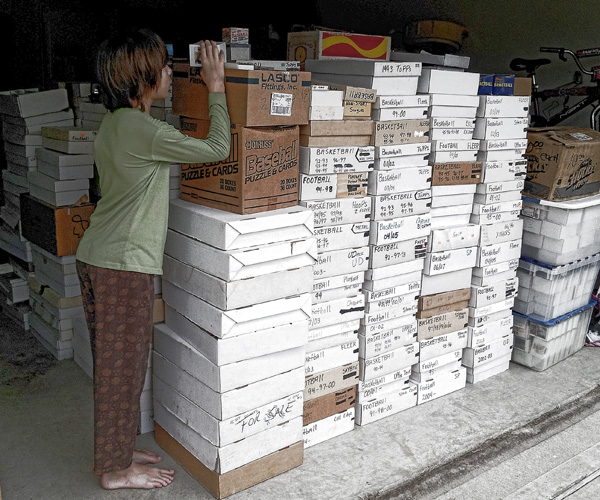
and multiply it by greater than 5. For each and every card in 1991 Topps. You can’t even see the mammoth amount of cards in that pic, but it is one massive solid cube of cardboard!
Because I love numbers, I wondered how long it would take to go through 4,000,000 cards. If you are shuffling at 4 cards per second (I’d say this is average; I’m VERY quick, clocking in at an all-time high of 16 CPS after having a monster energy drink) it would take you approximately 2,778 hours or well over a year’s worth of 40 hour work weeks to get through … just sifting through one card … of 1991 Topps.
Wanna try that with all 3.16 BILLION cards they produced that year? Well, if you did, and told me when you were done, I’d be waiting on you at some point in March of 3,062.
Let’s not forget the different versions:
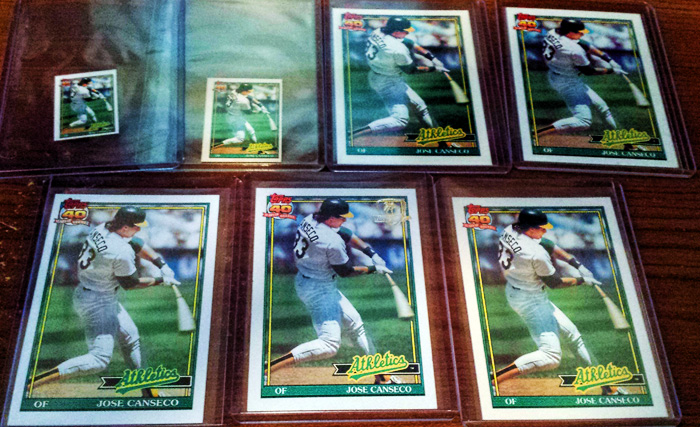
Pictures above are: Micro, Cracker Jack mini, regular, O-Pee-Chee, Tiffany, Promo back & Desert Shield.
It is amazing to think that ONE card was printed over 16x what the ENTIRE print run of every card from 2015 Topps Tek had. (This number is based upon the assumptions i had made in a previous article I had written.)
I know this all sounds crazy, and I’m sure you may be thinking “Okay, okay – I get it. They made a lot, so what?” Many people see 1991 Topps as a worthless product that only has one worthwhile card in it – the Chipper Jones rookie.
But what if I said that is wrong?
A Chipper may bring in 50 cents all day – which is BIG money, compared to the rest of the set. Your only hope for cracking something big would be to get Chipper graded. Or so I thought.
Take for instance good ol’ Dennis “Oil Can” Boyd.

He was no slouch, but let’s face it … no one is spending a penny on this card … right? WRONG!
Check this out:

This is the black tip flag variation. Even in this condition, it recently sold for $100. While this is not the normal pricing for all variations, there are a TON of variations and errors out there.
Take for instance, the bold back:

As Canseco is on a “C” sheet as denoted at the bottom of the card, you don’t see it show up as well as the bold red logo that shows up occasionally on the cards from the A & B sheets. A C sheet bold logo back of Walt Weiss recently sold for $40.
There are TONS of different errors and variations in this set – from different border line colors to statistical information that was later corrected, this set has found new life from a select group of collectors trying to put together a master set.
Perhaps one of my favorite quirks in this set is the black light test. I had read about it online, and decided to give it a try. I knew my son had a black light, and I just picked up some cards from a garage sale a few weeks ago. With that many ’91 Topps cards, the collection should have at least a few, correct?
I was right.
I hastily grabbed the black light and pile of 1991 Topps cards, then placed them all on the bathroom counter.
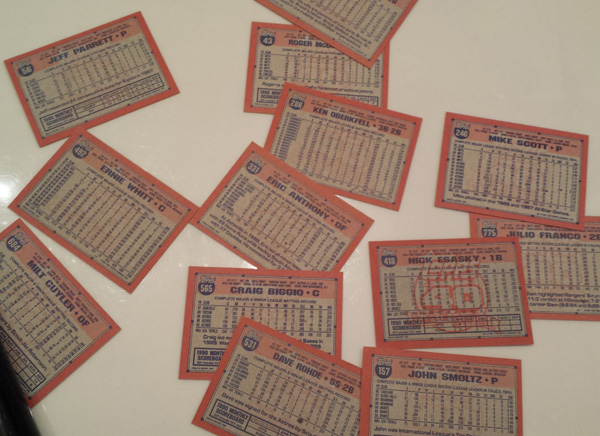
I immediately noticed one of the cards had the bold logo back variation. Cool! Things got were even more different when I turned on the black light (aside from the fact that it looks like I had the word “poo” written on my arm, only visible under the light?!)
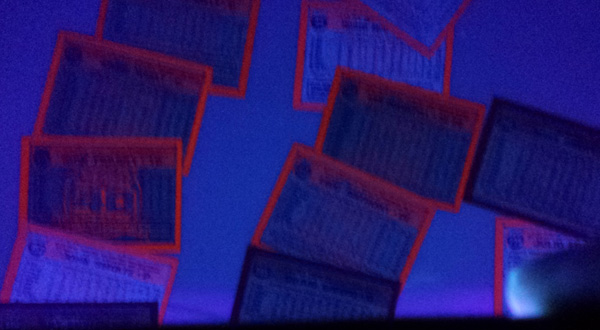
Keep in mind, these are ALL 1991 Topps regular. None are tiffany, o-pee-chee, traded, etc. All of them are regular. Check out the next pic to see a better view of the different variations:
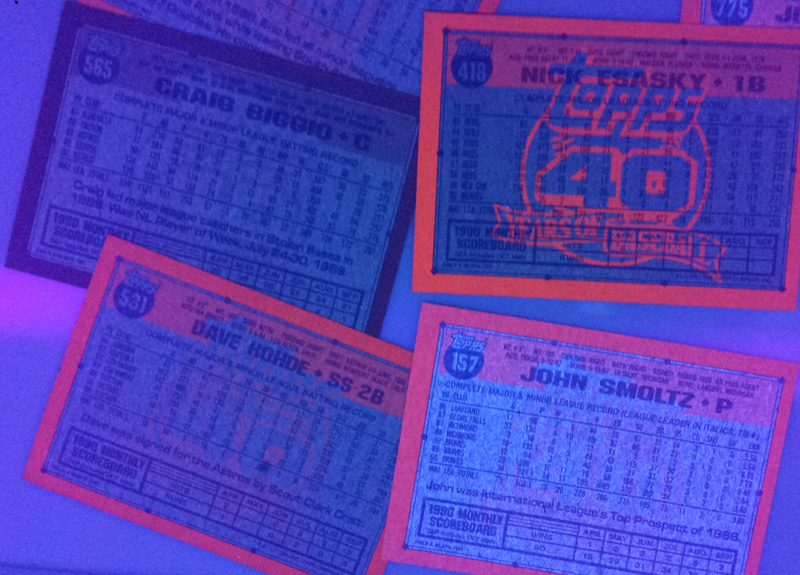
The glow backs / no-glow backs are by far my favorite variations. Both of my Cansecos look like the Dave Rohde card above.
Perhaps the most sought after type of 1991 Topps card is the Desert Shield version. I just recently read more about the back story on these cards. For me, the more of an interesting story, the more the cards mean to me.
Based upon my research, it looks like these were printed in approximate quantities of 5,000-6,800 per card. They were significantly rarer than the regular Topps cards. To make these even more rare, a lot of them were shipped overseas. They ended up being sent too late to be distributed, so several of them (it is unclear how many) were reportedly shipped back to the Myrtle Beach Air Force to be distributed to the 3,300 personnel @ 30 packs per person. Collectors would wait outside the gates trying to buy them.
To make these cards even more tough, many of these cards were thrown around while either being shipped overseas, or beat up by being carried around loosely in military personnel’s duffle bags.
This isn’t the only hurdle collectors have to deal with when finding a nice copy of their favorite player, though. These cards have a number of counterfeits, as well. Per the PSA website, the most notable three are as follows:
– The first forgery is easily noted by the tip of the shield coming to a point at the bottom. The entire logo is larger than the original as well.
– The second forgery is noted by the coconuts in the palm tree being barely distinguishable. The bottom palm tree front also touches the box that says “Operation Desert Shield”. The flag is also a lot larger, and has less of a wave.
– The third forgery is a lot more difficult to discern, and you will likely need a magnifying glass for this one. The stars on the flag are indistinguishable and just look like a bunch of bumps, as opposed to uniform dots left to right of 4, 3, 4 3.
I have even seen some with a stamp “copy” on the back.
While I know that the genuine article is the best, I for one sure would like a copy of each one of the forgeries for my collection as well! That is how sick we player collectors are, I guess.
In conclusion, 1991 Topps is not just a boring junk wax set – it has a LOT going on with it …. quite a bit more than meets the eye, so don’t try to keep your home warm by pitching them in the fireplace this winter just yet!

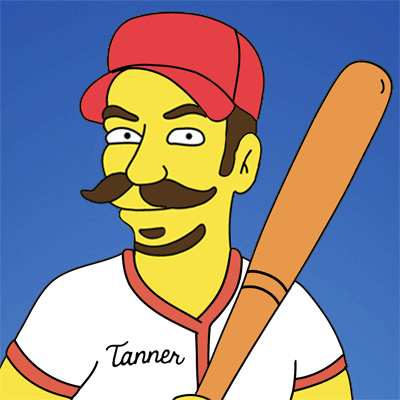

[…] actually wrote something about 1991 Topps not too many months ago – here is the link: 1991 Topps: The $100 Card, Glowing Backs & More – Tan Man Baseball Fan – or perhaps this is the one you were talking about? __________________ For the wages of sin is […]